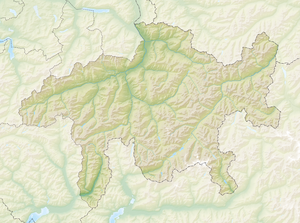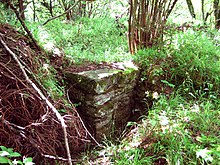Wildenberg Castle (Falera)
| Wildenberg Castle | ||
|---|---|---|
|
Wildenberg Castle - former castle hill west of Falera |
||
| Alternative name (s): | Casti da Chischlatsch | |
| Creation time : | around 1182 | |
| Castle type : | Hilltop castle | |
| Conservation status: | Wall remains, rubble, trenches | |
| Standing position : | Noble Free | |
| Place: | Falera | |
| Geographical location | 46 ° 48 '1 " N , 9 ° 13' 9" E | |
| Height: | 1100 m above sea level M. | |
|
|
||

The ruins of the former Wildenberg Castle are located in the area of the village Falera in the Surselva in the Swiss canton of Graubünden . The German name probably goes back to a family property in southern Germany. In Romansh the castle called Casti since Chischlatsch .
location
The ruins of the hilltop castle are located at 1100 m above sea level. M. west below the village of Falera on two hilltops on the left edge of the gorge "Val da Schluein".
investment
In front of the former elongated complex, hardly any wall remains have survived, so that more precise connections can no longer be made out; the whole hill is also heavily overgrown. A clearly recognizable neck ditch divided the complex into two parts, the main castle being assumed to be in the upper northern part . In the lower part there were probably agricultural buildings.
The southern plateau was surrounded by a curtain wall, of which sparse remains have been preserved. Poeschel noticed two cisterns inside the wall, but they can no longer be seen today.
At the southeastern foot of the hill, in the area of the ditch, traces of the wall were still found in the 1970s, which suggest a connection between the two parts. Today there is no more to be seen.
history
The Lords of Wildenberg were a noble noble family of the Vorderrhein Valley. They were related to the Frauenberg from neighboring Ruschein , to the Greifenstein from Filisur , to the Montalt, Belmont, all branches of the Carolingian barons of Sagogn and had extensive possessions around Falera, in Waltensburg and in the Engadin . Wildenberg Castle still stands in Zernez today .
In 1126, Hemma von Wolfertschwende, daughter of Hatto, founded the Rot monastery together with her son Cuno von Wildenberg . In 1257 the Wildenbergers are attested as governors of the Disentis monastery .
With Heinrich von Wildenberg, the male line died out in 1302. Via the heir daughter Anna von Wildenberg, who was married to the Disentis monastery bailiff Hugo von Werdenberg, the castle came into the possession of the Counts of Werdenberg-Heiligenberg through inheritance in 1319 . Which route the goods and rights of the Wildenberg took under the Werdenberg-Heiligenberg is difficult to estimate due to the sparse sources.
Wildenberg Castle is not mentioned in a document. It may have been abandoned early on when the Lords of Wildenberg became bailiffs of the monastery Pfäfers and moved their activities to the Sarganser area. In 1182 a papal document mentions a villa Wilperch and 1325 a gut ze Wildenberg ; However, it is unclear which locations were meant by this.
Around 1408 Wildenberg was owned by the Ringg von Baldenstein family, who came from the Surselva ; however, the castle was probably already in ruins at that time. Already on February 24, 1397 a knight Hans Ringg sealed a certificate with his seal S [IGILLUM] IOHANIS DI [CT] I PASSEL. The seal of Hans Ringg provides the final proof of the identity of Ringg and Passell (also Phasell or Phiesel). Simon Ringg «von Wildenberg» married the heiress of the Lord of Baldenstein Ulrich von Stain and adopted the title «von Baldenstein». The Ringg dropped the title "von Wildenberg".
The gravestone with the Rink coat of arms, which is installed as a lintel over the entrance to the tower in the church of St. Remigius von Falera , shows that there was a connection between those of Rink and Falera . It represents an axle nail . Its Latin name “paxillus” is the origin of the family name Passell.
literature
- Otto P. Clavadetscher, Werner Meyer : The castle book of Graubünden . Orell Füssli, Zurich 1984, ISBN 3-280-01319-4 .
- Ignaz Cathomen, Isidor Winzap: Falera - History of the development of a mountain village in Graubünden . Falera parish 2002
Web links
Individual evidence
- ^ Wartmann: Rhaetian documents No. 124
- ^ The Rink family in the history of Churrätien , Untervaz Castle Association, PDF



